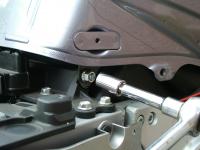Dale2010
Well-known member
Just a hint for removing gas tanks (for those interested)...
Part of gas tank removal involves removing the fuel line fitting. This involves sliding the orange section of the clamp outward and then compressing the two small gray rectangles on each side of the fitting to release the fuel line from the tank. Those of us with big fingers tend to have problems with this (squeezing and releasing the grey buttons on the clamp).
Here's an idea I use (after dropping my disconnected tank on the floor while trying to remove the clamp). Use or buy a cheap set of needle nose pliers. Using a vice, bend each jaw about 45 degrees (about 1.5 cm from the tip) inward (tips will then close with only the ends touching). This makes a cheap and perfect tool for releasing the connection clamp on the fuel tank and will prove especially useful for those of us with large fingers.
FWIW
Part of gas tank removal involves removing the fuel line fitting. This involves sliding the orange section of the clamp outward and then compressing the two small gray rectangles on each side of the fitting to release the fuel line from the tank. Those of us with big fingers tend to have problems with this (squeezing and releasing the grey buttons on the clamp).
Here's an idea I use (after dropping my disconnected tank on the floor while trying to remove the clamp). Use or buy a cheap set of needle nose pliers. Using a vice, bend each jaw about 45 degrees (about 1.5 cm from the tip) inward (tips will then close with only the ends touching). This makes a cheap and perfect tool for releasing the connection clamp on the fuel tank and will prove especially useful for those of us with large fingers.
FWIW





















































